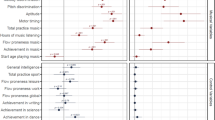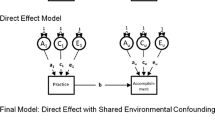Abstract
Analyses of musical ability data from the Loehlin and Nichols National Merit Scholarship study are presented. Musical ability is indexed by four measures: interest in a profession in music, performance in school, performance outside of school, and receiving honors in music. These variables pose a challenge for behavior genetic analysis since they do not conform to the assumptions of traditional linear models. For example, there is a dependent relationship between the honors and the performance variables; one cannot obtain honors without performance. Several methods were employed to deal with these relationships, and the following conclusions appeared regardless of the method used. First, twin correlations were always high, ranging from 0.44 to 0.90 in monozygotic (MZ) twins and from 0.34 to 0.83 in dizygotic (DZ) twins. Second, although there was evidence for heritable variation, the effects of common environment were almost always larger than the effects of heredity. Third, marital assortment was not of sufficient magnitude to account for these common environment effects. In the young adults in this sample, musical ability is influenced more by shared family environment than by shared genes.
Similar content being viewed by others
References
Ashman, R. (1952). The inheritance of simple musical memory.J. Hered. 43:51–52.
Coon, H., and Carey, G. (1987). Twins and musical ability: An analysis of if-then relationships.Behav. Genet. 17:620 (abstr.).
Fry, D. (1948). An experimental study of tone deafness.Speech 1:4–11.
Fuller, J., and Thompson, W. (1978).Foundations of Behavior Genetics, C. V. Mosby, St. Louis, Mo., pp. 260–262.
Herman, E. (1981).Shinichi Suzuki: The Man and His Philosophy, Ability Associates, Athens, Ohio, pp. 136–225.
Kalmus, H. (1949). Tune deafness and its inheritance.Proc. 10th Int. Congr. Genet., Stockholm.
LaBuda, M. C., DeFries, J. C., and Fulker, D. W. (1986). Multiple regression analysis of twin data obtained from selected samples.Genet. Epidemiol. 3:425–433.
Loehlin, J. C., and Nichols, R. C. (1976).Heredity, Environment, and Personality, University of Texas Press, Austin.
Lundin, R. W. (1953).An Objective Psychology of Music, Ronald Press, New York.
Mjoen, J. (1926). Genius as a biological problem.Eugen. Rev. 17:242–257.
Musell, J. L. (1937).The Psychology of Musci, W. W. Norton, New York, pp. 331–339.
Neu, D. (1947). Acritical review of the literature on “absolute pitch.”Psychol. Bull. 44:249–266.
Plomin, R., and DeFries, J. C. (1983). The Colorado Adoption Project.Child Dev. 54:276–289.
Reser, H. (1935). Inheritance of musical ability.Eugen. News 20:8–9.
Revesz, G. (translator, de Courcy) (1954).Introduction to the Psychology of Music, University of Oklahoma Press, Norman, pp. 186–195.
Scheinfeld, A. (1956).The New Heredity and You, Chatto and Windus, London.
Seashore, C. E. (1919).The Psychology of Musical Talent, Silver Burdett, New York.
Shuter, R. (1968).The Psychology of Musical Ability, Methuen, London, pp. 113–176.
Simons, G. (1964). Comparisons of incipient music responses among very young twins and singletons.J. Res. Music Educ. 12:212–226.
Simons, G. (1986). Early childhood musical development: A survey of selected research.Council Res. Music Educ. 86:36–52.
Stafford, R. (1965). Nonparametric analysis of twin data with the Mann-Whitney U-test. Research Report No. 10, Louisville Twin Study, Child Development Unit, University of Louisville School of Medicine, Louisville, Ky.
Stanton, H. (1922). Inheritance of specific musical capacities.Psychol. Monogr. 31(140):157–204.
Vandenberg, S. G. (1962). The Hereditary Abilities Study: Hereditary components in a psychological test battery.Am. J. Hum. Genet. 14:230–233.
Author information
Authors and Affiliations
Additional information
This research was supported in part by Grants HD-10333 and HD-18426 from the National Institute of Child Health and Human Development (NICHD). The paper was written while Hilary Coon was under the support of Training Grant HD-07289 from the NICHD. Preparation of the paper was facilitated by Grant RR-07013-20 awarded to the University of Colorado by the Biomedical Research Support Grant Program, Division of Research Resources, National Institutes of Health.
Rights and permissions
About this article
Cite this article
Coon, H., Carey, G. Genetic and environmental determinants of musical ability in twins. Behav Genet 19, 183–193 (1989). https://doi.org/10.1007/BF01065903
Received:
Accepted:
Issue Date:
DOI: https://doi.org/10.1007/BF01065903




